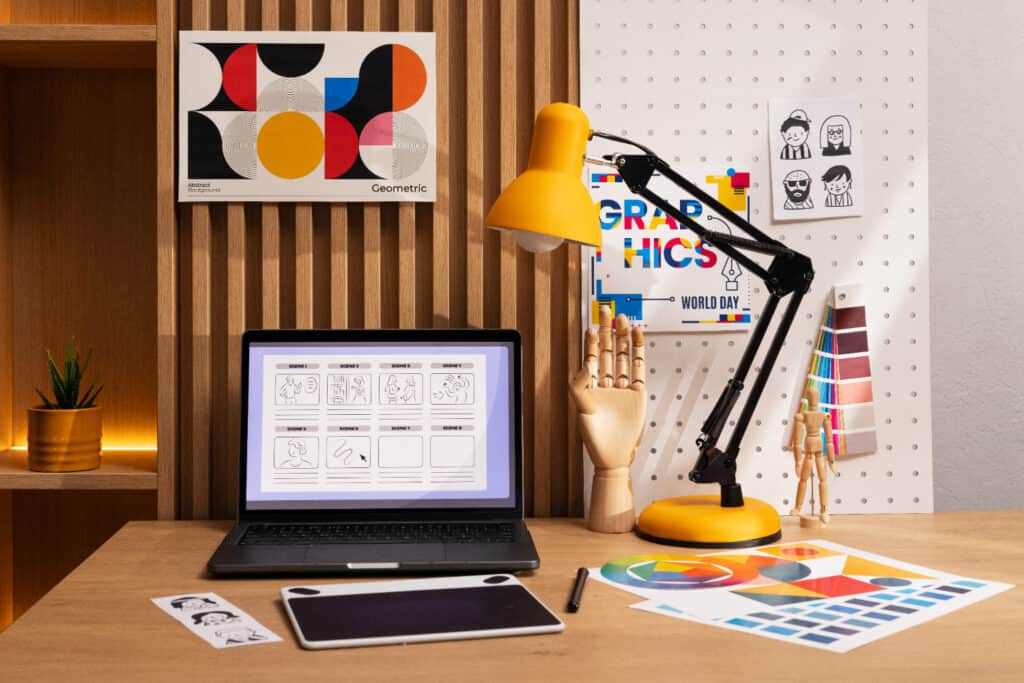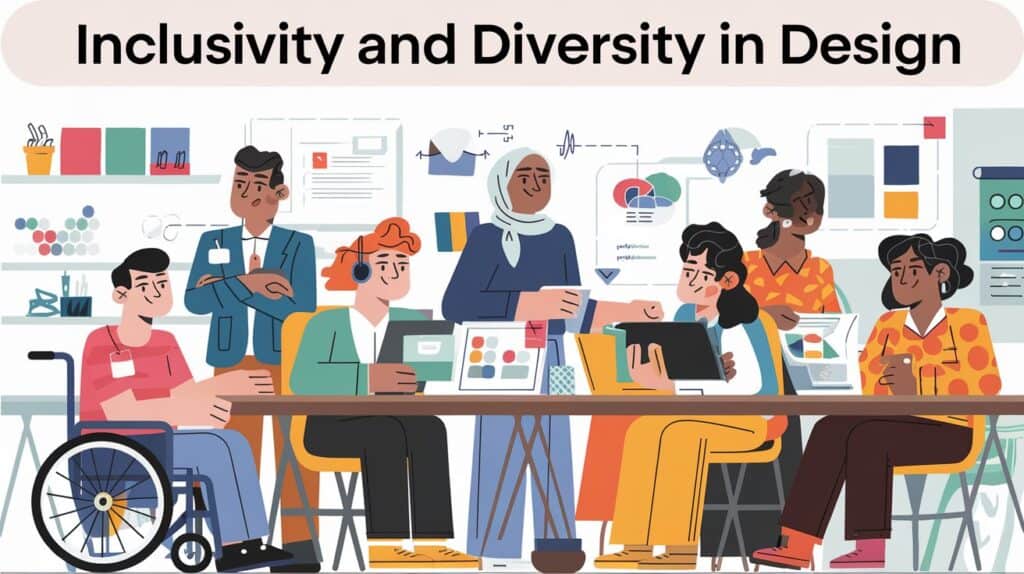Introduction
Graphic design has long served as a visual language for human expression, communication, and storytelling. Between 2010 and 2025, the industry underwent seismic shifts driven by cultural changes, technological breakthroughs, and new tools. This era, rich with innovation, redefined what design could achieve, reflecting societal evolution and technological progress.
This article delves into the evolution of graphic design trends over the past 15 years, highlighting the transition from minimalism to the rise of immersive, futuristic styles. By examining key trends, we can understand how design shaped and responded to global shifts, creating a blueprint for the creative industry’s future.
Table of Contents
Graphic Design in 2010: A Minimalist Beginning
At the start of the 2010s, minimalism dominated the design world. This aesthetic emphasized simplicity, favoring clean lines, ample white space, and functional visuals. Minimalist design was practical, addressing the demands of faster loading websites, mobile interfaces, and the rise of responsive web design.
Brands embraced minimalism to communicate professionalism and clarity. Apple was a trailblazer, with its sleek product designs and minimalist marketing campaigns epitomizing this trend. Websites shifted away from cluttered layouts, focusing instead on user experience, clean navigation, and concise messaging.
Minimalism’s appeal extended beyond practicality—it aligned with an emerging preference for de-cluttered lifestyles, reflecting a cultural movement toward simplicity.

Typography Revolution: From Static to Expressive
Typography took center stage during the 2010s, transforming from a functional element into a creative powerhouse. Handwritten fonts gained traction, bringing warmth and authenticity to designs. These fonts resonated with audiences seeking personalized, humanized experiences.
Bold typography emerged as a statement-making tool. Designers used oversized, sans-serif fonts to grab attention and convey messages powerfully. The rise of Google Fonts democratized access to diverse typefaces, allowing even small creators to experiment with typography.
This era also saw kinetic typography, where animated fonts brought motion and storytelling into the mix. From websites to video intros, typography evolved into a dynamic medium for creative expression.
The Rise of Flat Design
By the mid-2010s, flat design had taken the digital world by storm. It rejected the skeuomorphic elements of the 2000s, which mimicked real-world textures and objects, in favor of simplified, two-dimensional aesthetics.
Flat design’s appeal lay in its clarity and functionality. By eliminating unnecessary details, it enhanced readability and reduced visual noise. Microsoft and Apple adopted flat design for their operating systems, signaling a major industry shift.
Flat design also paved the way for scalability, ensuring that visuals retained their integrity across devices—a crucial factor in the era of responsive design.
2015: The Shift to Material Design
In 2014, Google introduced Material Design, combining the simplicity of flat design with subtle realism. This approach incorporated depth, shadows, and layered elements, making interfaces more intuitive and engaging.
Material Design prioritized usability, with its structured layouts guiding users seamlessly through content. Its aesthetic, inspired by real-world materials like paper and ink, struck a balance between modernity and familiarity.
By 2015, Material Design had become the standard for app and web interfaces, influencing countless platforms and inspiring a generation of designers.

Gradients and Vibrant Colors: A Comeback
Gradients, once dismissed as outdated, made a triumphant return during the late 2010s. This time, they featured bold, vibrant hues that added energy and depth to designs.
Instagram’s 2016 logo redesign was a watershed moment for gradients. The brand’s multicolored gradient became iconic, inspiring other companies to adopt similar palettes. Designers experimented with color transitions, creating eye-catching visuals for digital and print media alike.
This trend symbolized a break from flat design’s rigidity, offering a richer, more dynamic visual language.
Micro-interactions in UI/UX
Micro-interactions—subtle animations or design elements that respond to user actions—became a cornerstone of UI/UX design. These tiny, often unnoticed details enhanced user engagement by providing feedback, guiding navigation, or adding moments of delight.
Think of a heart icon that animates when clicked or a button that subtly changes color when hovered over. Micro-interactions humanized digital interfaces, making them feel intuitive and responsive.
By 2020, they were no longer a bonus feature but an essential part of user experience design.
The Age of Animation and Motion Graphics
Advancements in technology made animation accessible to more designers, leading to an explosion of motion graphics in branding and marketing. Animated logos, explainer videos, and interactive websites became ubiquitous.
Motion graphics allowed brands to tell richer stories and convey emotions in ways static visuals couldn’t. Tools like Adobe After Effects and Blender democratized animation, enabling even small teams to create stunning visuals.
The rise of video content on platforms like Instagram and TikTok further fueled the demand for motion-based design, making it a staple of digital marketing.
Abstract Art in Design
The 2020s saw a resurgence of abstract art in graphic design. Designers embraced unconventional shapes, bold patterns, and vibrant colors to create visually arresting compositions. Abstract art allowed for creative freedom, offering a break from structured, grid-based layouts.
Brands used abstract visuals to stand out, convey modernity, and spark curiosity. This trend thrived in a world increasingly saturated with digital content, offering a fresh and experimental aesthetic.

Vintage and Retro Styles
Nostalgia has always been a powerful emotional tool in design, and the 2010s witnessed a revival of vintage and retro aesthetics. Inspired by the 80s and 90s, designers reimagined old-school styles with modern twists.
From neon color schemes to pixel art, retro design became a way to tap into collective memories. This trend was particularly evident in entertainment, fashion, and branding, where nostalgia resonated deeply with audiences.
Data-Driven Design and Infographics
With the rise of big data, designers were tasked with making complex information digestible. Infographics became a popular solution, combining visuals with data to tell compelling stories.
This era also saw advancements in data visualization, with designers using interactive charts and 3D graphics to present information dynamically. Tools like Tableau and D3.js empowered creators to bridge the gap between aesthetics and functionality.
Inclusivity and Diversity in Design
By the 2020s, inclusivity became a central theme in graphic design. Brands moved away from stereotypical imagery, embracing diverse representations in their visuals.

Stock photo libraries expanded to include more varied depictions of race, gender, age, and body types. Designers also prioritized accessibility, ensuring that their work was usable by people with disabilities, including colorblind-friendly palettes and screen-reader-compatible layouts.
This shift reflected a broader societal push for equity and representation, making design a powerful tool for social change.
Future Predictions for 2025 and Beyond
As we look ahead, graphic design trends will likely continue to evolve with technological advancements. Key predictions include:
- AI-Powered Design Tools: Artificial intelligence will automate repetitive tasks, enabling designers to focus on creativity. Tools like Canva and Adobe’s Sensei hint at what’s to come.
- AR and VR Integration: Augmented and virtual reality will redefine experiential design, offering immersive storytelling possibilities.
- Sustainability: Eco-conscious design will push brands toward sustainable materials, minimalist packaging, and green branding strategies.
- Hyper-Personalization: Data-driven design will allow brands to create tailored experiences for individual users, deepening engagement.
The future promises to blur boundaries between the digital and physical worlds, creating new opportunities for designers to innovate.
Conclusion
The evolution of graphic design trends from 2010 to 2025 showcases the industry’s ability to adapt, innovate, and inspire. From the rise of minimalism to the advent of AR, these 15 years have been a testament to the power of creativity in shaping the visual world.
As we embrace the future, one thing is clear: graphic design will continue to evolve, pushing boundaries and redefining what’s possible in the visual arts.
Future Predictions for 2025
As we move forward, graphic design continues to blur the boundaries between the physical and digital worlds. Trends such as AI-powered design tools, the integration of AR/VR, and a stronger focus on sustainability are expected to redefine creativity in the years to come.
Conclusion
The 2020s saw an increase in the use of abstract art as a creative outlet. Designers experimented with unconventional shapes, bold patterns, and vibrant colors to craft visually arresting designs that defied traditional norms. As we move forward, graphic design continues to blur the boundaries between the physical and digital worlds. Trends such as AI-powered design tools, the integration of AR/VR, and a stronger focus on sustainability are expected to redefine creativity in the years to come. The journey of graphic design from 2010 to 2025 reflects a vibrant tapestry of innovation, experimentation, and adaptation. As designers embrace new tools and technologies, the future of graphic design promises to be as dynamic and transformative as the past 15 years.


0 Comments